![]()
The Magical World of Daniel Luna
Reviewed by Tessa Bielecki
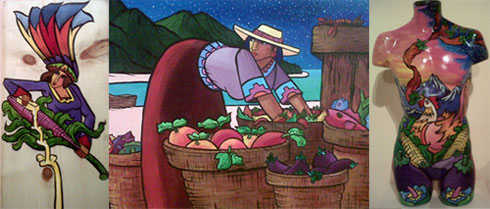
Saguaro cactus, red chili peppers, calla lilies, stone canyons and cow skulls bleached in the desert sun - these are some of the varied themes in the art of Daniel Luna, one of Denver's most prolific painters.
A retrospective of more than sixty pieces of his art are featured at Denver's Museo de las Americas until May 28, 2012. Fr. Dave and I attended an evening of "conversation" with Luna and were enchanted by what he calls the "carnival ride" of his art.
Luna says, "I use images that people are familiar with so they can create their own theater and feel like it's OK to imagine." He describes his art as the "solidified passion of cherished moments" and the "beautiful magic of dreaming while awake."
Now 57, Luna uses vibrant primary colors and tells us they are even more vibrant in his mind. He sports a long gray ponytail and suffers from a rare eye disease that forces him to wear thick glasses. He paints not only on canvas but also on mannequins, boards, and flower pots. He rarely sleeps and creates twelve or more hours a day. When one medium ceases to be "an adventure" and becomes "a chore," he chooses another medium.
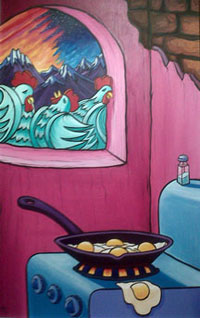 Usually an element of what Luna calls "fun" permeates his work. I prefer to call this his "celebration of life." A woman in a cowboy hat reads a newspaper while a rhinoceros looks on. A couple experience their first kiss at a drive-in movie with Godzilla breathing fire on the screen. Indigenous people in sombreros slather ears of blue corn with whole sticks of butter while a river of butter sticks flows by. "The Horror of Breakfast" with dismayed chickens looking through the window - how does a chicken look "dismayed?" - while their eggs fry on the stove and one slides off the edge. It was interesting to hear that what I saw as a playful painting was inspired by Marlon Brando in Apocalypse Now, moaning over and over again, "The horror, the horror."
Usually an element of what Luna calls "fun" permeates his work. I prefer to call this his "celebration of life." A woman in a cowboy hat reads a newspaper while a rhinoceros looks on. A couple experience their first kiss at a drive-in movie with Godzilla breathing fire on the screen. Indigenous people in sombreros slather ears of blue corn with whole sticks of butter while a river of butter sticks flows by. "The Horror of Breakfast" with dismayed chickens looking through the window - how does a chicken look "dismayed?" - while their eggs fry on the stove and one slides off the edge. It was interesting to hear that what I saw as a playful painting was inspired by Marlon Brando in Apocalypse Now, moaning over and over again, "The horror, the horror."
The artist grew up wanting to be a musician, while his closest musician friend wanted to be an artist. "We didn't know who to see to make the switch," he chuckles. (When he paints people playing music, the "sound" looks like red and orange fireworks!) "I also wanted to be a behavioral psychologist," he confesses. "You are," someone calls out from the audience. "And I've gotten better results, too," he jokes.
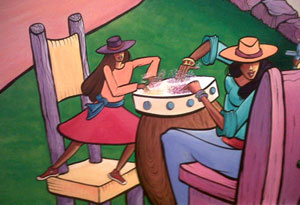 Luna is fascinated by the strength, stability and beauty of women and loves to paint their "constancy and calmness." Some of these women are brown-skinned and buxom, dressed in bright colors as they cook, sort fish and vegetables, or burn valentines in heart-shaped eyeglasses. Others are thin, pale, and reflective. In "The Death of Fun," Luna shows us Pablo Picasso's last wife on the day the great artist died, leaving her bereft. I was moved by the tragic depth of sorrow Luna captured in the face of the grieving widow.
Luna is fascinated by the strength, stability and beauty of women and loves to paint their "constancy and calmness." Some of these women are brown-skinned and buxom, dressed in bright colors as they cook, sort fish and vegetables, or burn valentines in heart-shaped eyeglasses. Others are thin, pale, and reflective. In "The Death of Fun," Luna shows us Pablo Picasso's last wife on the day the great artist died, leaving her bereft. I was moved by the tragic depth of sorrow Luna captured in the face of the grieving widow.
Luna painted his wife, Paula Leek, eating her cake before her steak which she's done since he first met her nearly twenty years ago. Her midriff is bare, and her jeans are unbuttoned at the waist. "Luna loves to mix the erotic with the commonplace," says Maruca Salazar, executive director of the museum and curator for the show, "because he sees no difference." I found his fruits, vegetables and flowers as voluptuous as his women.
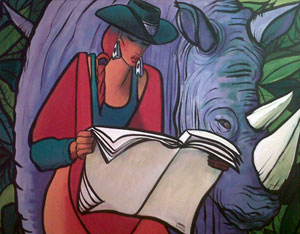
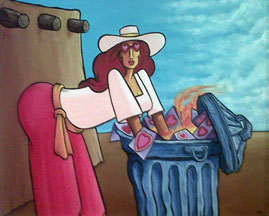 I was highly amused by the painting of a muscular and curvaceous woman lifting weights and smoking a cigarette in between loads of laundry while a wolf crawls out of the dryer. Luna told us about the inspiration behind this work. Maruca Salazar worked with Clarissa Pinkoles-Estes on her book, Women who Run with Wolves. This painting is Luna's tribute to feminine power, although another woman who viewed the work said the wolf is the one responsible for lost socks! Luna took time to tell us about the joy he experienced painting even the details of the Clorox bottle!
I was highly amused by the painting of a muscular and curvaceous woman lifting weights and smoking a cigarette in between loads of laundry while a wolf crawls out of the dryer. Luna told us about the inspiration behind this work. Maruca Salazar worked with Clarissa Pinkoles-Estes on her book, Women who Run with Wolves. This painting is Luna's tribute to feminine power, although another woman who viewed the work said the wolf is the one responsible for lost socks! Luna took time to tell us about the joy he experienced painting even the details of the Clorox bottle!
I did not see what I consider Luna's most provocative painting in the art show but in The Denver Post. A robed "Day of the Dead" skeleton holds a computer in one hand and tosses books into a fire with the other. Meanwhile half-clad native people pile discarded books into their canoe at the water's edge. This painting made me fall in love with Luna's work and decide to see his exhibit. I'm technophobic and seriously lament our culture's substitution of the internet for books-in-print. Luna told us he also fears we will lose our imaginations by overusing the computer and also lose "the grace of gesture and communication."
 "I like it when humans put their hands on something," he says, so his art celebrates our sense of touch. An old man places his hand on a turtle, a child rolls avocadoes down the steps, a tall svelte woman in a green dress holds a cup of "strong coffee," the liquid solidifying in her hand and breaking the cup. Smiling women dressed in yellow touch bunches of purple grapes which adorn the picture frame as well. (This painting is happily called "No Wrath Here.")
"I like it when humans put their hands on something," he says, so his art celebrates our sense of touch. An old man places his hand on a turtle, a child rolls avocadoes down the steps, a tall svelte woman in a green dress holds a cup of "strong coffee," the liquid solidifying in her hand and breaking the cup. Smiling women dressed in yellow touch bunches of purple grapes which adorn the picture frame as well. (This painting is happily called "No Wrath Here.")
Luna's night skies are filled with thousands of tiny stars. "How do you achieve this look?" asks one woman. "It's an 'audio decision,'" Luna replies. He paints the skies "free flow" but sets a parameter, painting only as many stars as a certain number of songs play on the "mix tapes" he makes himself. He usually paints to a variety of music: country, classical, blues, soundtracks, female vocalists.
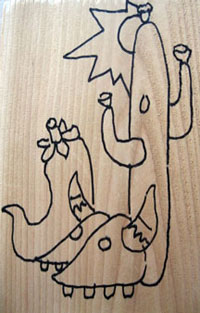 For our evening at the museum, we were all seated around tables covered with paints and brushes. Luna drew some sketches on small boards, or we could create our own and then paint them. I was delighted when he drew one with three of my favorite southwestern symbols!
For our evening at the museum, we were all seated around tables covered with paints and brushes. Luna drew some sketches on small boards, or we could create our own and then paint them. I was delighted when he drew one with three of my favorite southwestern symbols!
If you live close to Denver, you have an opportunity to see this uplifting exhibit at the Museo de las Americas, 861 Santa Fe Drive. For details call 303-571-4401 or visit museo.org.
You're in for a treat. As Luna puts it, "Maybe my artwork is like little night lights for people to put by their beds of imagination to keep away the bogey-man of mediocrity."